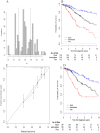Integrating Tenascin-C protein expression and 1q25 copy number status in pediatric intracranial ependymoma prognostication: A new model for risk stratification
- PMID: 28617804
- PMCID: PMC5472261
- DOI: 10.1371/journal.pone.0178351
Integrating Tenascin-C protein expression and 1q25 copy number status in pediatric intracranial ependymoma prognostication: A new model for risk stratification
Abstract
Purpose: Despite multimodal therapy, prognosis of pediatric intracranial ependymomas remains poor with a 5-year survival rate below 70% and frequent late deaths.
Experimental design: This multicentric European study evaluated putative prognostic biomarkers. Tenascin-C (TNC) immunohistochemical expression and copy number status of 1q25 were retained for a pooled analysis of 5 independent cohorts. The prognostic value of TNC and 1q25 on the overall survival (OS) was assessed using a Cox model adjusted to age at diagnosis, tumor location, WHO grade, extent of resection, radiotherapy and stratified by cohort. Stratification on a predictor that did not satisfy the proportional hazards assumption was considered. Model performance was evaluated and an internal-external cross validation was performed.
Results: Among complete cases with 5-year median follow-up (n = 470; 131 deaths), TNC and 1q25 gain were significantly associated with age at diagnosis and posterior fossa tumor location. 1q25 status added independent prognostic value for death beyond the classical variables with a hazard ratio (HR) = 2.19 95%CI = [1.29; 3.76] (p = 0.004), while TNC prognostic relation was tumor location-dependent with HR = 2.19 95%CI = [1.29; 3.76] (p = 0.004) in posterior fossa and HR = 0.64 [0.28; 1.48] (p = 0.295) in supratentorial (interaction p value = 0.015). The derived prognostic score identified 3 different robust risk groups. The omission of upfront RT was not associated with OS for good and intermediate prognostic groups while the absence of upfront RT was negatively associated with OS in the poor risk group.
Conclusion: Integrated TNC expression and 1q25 status are useful to better stratify patients and to eventually adapt treatment regimens in pediatric intracranial ependymoma.
Conflict of interest statement
Figures




References
-
- Andreiuolo F, Puget S, Peyre M, Dantas-Barbosa C, Boddaert N, Philippe C, et al. Neuronal differentiation distinguishes supratentorial and infratentorial childhood ependymomas. Neuro-Oncol. 2010;12: 1126–1134. doi: 10.1093/neuonc/noq074 - DOI - PMC - PubMed
-
- Puget S, Grill J, Valent A, Bieche I, Dantas-Barbosa C, Kauffmann A, et al. Candidate genes on chromosome 9q33-34 involved in the progression of childhood ependymomas. J Clin Oncol Off J Am Soc Clin Oncol. 2009;27: 1884–1892. doi: 10.1200/JCO.2007.15.4195 - DOI - PubMed
-
- Taylor MD, Poppleton H, Fuller C, Su X, Liu Y, Jensen P, et al. Radial glia cells are candidate stem cells of ependymoma. Cancer Cell. 2005;8: 323–335. doi: 10.1016/j.ccr.2005.09.001 - DOI - PubMed
-
- Witt H, Mack SC, Ryzhova M, Bender S, Sill M, Isserlin R, et al. Delineation of two clinically and molecularly distinct subgroups of posterior fossa ependymoma. Cancer Cell. 2011;20: 143–157. doi: 10.1016/j.ccr.2011.07.007 - DOI - PMC - PubMed
-
- Parker M, Mohankumar KM, Punchihewa C, Weinlich R, Dalton JD, Li Y, et al. C11orf95-RELA fusions drive oncogenic NF-κB signalling in ependymoma. Nature. 2014;506: 451–455. doi: 10.1038/nature13109 - DOI - PMC - PubMed
Publication types
MeSH terms
Substances
LinkOut - more resources
Full Text Sources
Other Literature Sources
Miscellaneous

